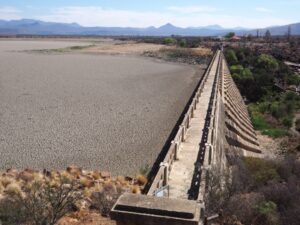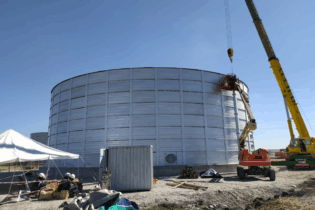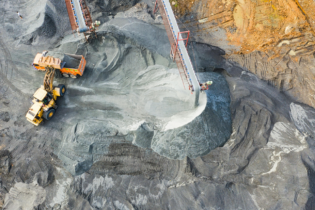Siltation reduces dam storage – vital for water supply and the economy. Managing this is crucial. The Department of Water and Sanitation (DWS) assigned the Water Research Commission (WRC) to develop a National Siltation Management Strategy (NatSilt). One of the key deliverables is capacity building.
The NatSilt programme has resulted in the development of four different qualifications to address the managerial, technical, operational and collaborative aspects of siltation management. The skills programmes have all been registered and accredited with the Quality Council for Trades and Occupation. Each of them has their own Recognition of Prior Learning framework. An e-learning platform has been developed to facilitate classroom-based learning and assessments, enhancing accessibility and flexibility for learners. Recognition of prior learning (RPL) framework| Aspects of siltation management | Position/course | RPL |
| Management | Dam Siltation Manager | NQF 8 |
| Technical | Dam Siltation Practitioner | NQF 5 |
| Operation | Dam Siltation Process Controller | NQF 3 |
| Collaboration | Dam Siltation Network and Partnership Coordinator | NQF 5 |
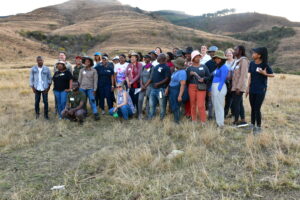 SLPs bridge these knowledge gaps and equip individuals with the necessary skills and expertise. Siltation continues to pose significant challenges to water infrastructure and ecosystem health, leading to a growing demand for professionals with expertise in siltation management. SLPs offer a flexible and accessible way for individuals already working in the water sector to acquire specialised knowledge and skills relevant to their roles, ensuring that graduates are well prepared to meet the demands of the job market.
Lifelong learning is essential for professionals to stay up to date with emerging trends, technologies, and best practices in their field. SLPs provide a convenient and efficient way for individuals to engage in continuous learning and professional development while balancing work and other commitments.
Collaborating with academic institutions such as UJ allows for the integration of research, expertise, and resources into the development and delivery of SLPs. This partnership ensures that the SLPs are academically rigorous, relevant to industry needs, and supported by the latest advancements in siltation management science and technology.
SLPs bridge these knowledge gaps and equip individuals with the necessary skills and expertise. Siltation continues to pose significant challenges to water infrastructure and ecosystem health, leading to a growing demand for professionals with expertise in siltation management. SLPs offer a flexible and accessible way for individuals already working in the water sector to acquire specialised knowledge and skills relevant to their roles, ensuring that graduates are well prepared to meet the demands of the job market.
Lifelong learning is essential for professionals to stay up to date with emerging trends, technologies, and best practices in their field. SLPs provide a convenient and efficient way for individuals to engage in continuous learning and professional development while balancing work and other commitments.
Collaborating with academic institutions such as UJ allows for the integration of research, expertise, and resources into the development and delivery of SLPs. This partnership ensures that the SLPs are academically rigorous, relevant to industry needs, and supported by the latest advancements in siltation management science and technology.
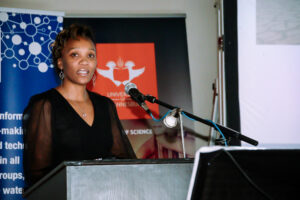 Furthermore, they offer a flexible and accessible pathway to education for individuals who may not have the time, resources, or inclination to pursue traditional full-time studies. By offering modular and bite-sized learning opportunities, these programmes cater to diverse learners with varying backgrounds, experiences, and learning styles, democratising access to education and empowering a broader range of individuals to contribute to siltation management efforts.
Six SLPs were developed from the four skills programmes. While the skills programmes are formal qualifications, the SLPs accommodate individuals who do not wish to partake in a long-term learning intervention. Enrolment will begin in the second semester at UJ in July 2024.
Short learning programmes (SLPs)
Furthermore, they offer a flexible and accessible pathway to education for individuals who may not have the time, resources, or inclination to pursue traditional full-time studies. By offering modular and bite-sized learning opportunities, these programmes cater to diverse learners with varying backgrounds, experiences, and learning styles, democratising access to education and empowering a broader range of individuals to contribute to siltation management efforts.
Six SLPs were developed from the four skills programmes. While the skills programmes are formal qualifications, the SLPs accommodate individuals who do not wish to partake in a long-term learning intervention. Enrolment will begin in the second semester at UJ in July 2024.
Short learning programmes (SLPs)
| Course | RPL |
| Dam Siltation Manager | NQF 8 |
| Dam Siltation Practitioner | NQF 5 |
| Dam Siltation Process Controller Part 1 | NQF 4 |
| Dam Siltation Process Controller Part 2 | NQF 4 |
| Dam Siltation Process Controller Practical | NQF 4 |
| Dam Siltation Network and Partnership Coordinator | NQF 6 |
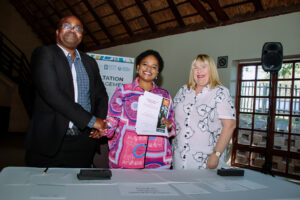 Each SLP requires a different level of prior learning. Gaegane adds that the aim is to give as many people as possible access to the programmes. “This is not just for DWS employees. We do not want to leave anyone behind in terms of skills development and capacity building. Therefore, we have created an RPL Framework where people that do not have the requisite NQF level can apply for the SLP using their experience within the sector. Furthermore, since NatSilt is a national programme, we aim to form relationships with other universities in other provinces.
Each SLP requires a different level of prior learning. Gaegane adds that the aim is to give as many people as possible access to the programmes. “This is not just for DWS employees. We do not want to leave anyone behind in terms of skills development and capacity building. Therefore, we have created an RPL Framework where people that do not have the requisite NQF level can apply for the SLP using their experience within the sector. Furthermore, since NatSilt is a national programme, we aim to form relationships with other universities in other provinces.
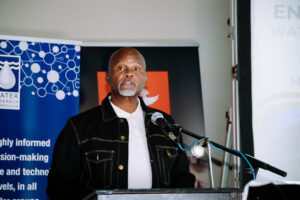 He adds that while outsourcing technical capacity is sometimes needed, it is important to continue to build internal technical capacity as well. “That internal capacity allows us to deal with technical partners outside the department from an informed position. We are committed to attracting, growing, and retaining technical skill. These SLPs will assist us in building capacity to boost the improved operation and maintenance of our water infrastructure. They will create professionals in siltation management.”
There is a drive to increase the yield of water infrastructure that allows the country to meet growing water demands. While there are a number of projects undertaken by the DWS to raise the height of existing dam walls to boost reservoir capacities, siltation is decreasing reservoir volumes. “These SLPs will be instrumental in building knowledge and specialisation around siltation management within the DWS. This will ultimately influence policy development and planning around the operation and maintenance of our dams and reservoirs,” explains Monene.
“During the pilot implementation of the NatSilt programme, it became obvious that stakeholder engagement from a national, provincial, regional, and local level was central to the programme’s success. It is important to instil a collaborative approach instead of various institutions and organisations working in silos. This collaborative approach is essential, as the DWS cannot manage dam siltation on its own. These SLPs will go a long way to assist us,” adds Gaegane.
The SLPs align with the National Skills Development Strategy (NSDS) III Goal 4.7, Outcome 4.7.2 of the Department of Higher Education and Training in South Africa. They aim to increase public sector capacity and support the building of a developmental state. The programmes are designed to meet new training needs and build workforce capacity. Successful completion of the SLPs will enable learners to play a vital role in sustaining collaborations at the catchment level and developing viable catchment communities that support the maintenance of dams. This will contribute to the long-term sustainability of water resources in South Africa, aligning with the 2030 National Development Plan, explains Dr Lee-Ann Modley, senior lecturer and deputy head of department: Geography & Environmental Management & Energy Studies, UJ.
She adds that the SLPs will improve students’ access to excellent educational opportunities across various fields and disciplines, aligning with UJ’s mission and strategic objective of ‘Excellence in Teaching and Learning’ adopted as part of its Strategic Plan of 2025. It will facilitate collaboration in teaching and learning between two academic departments in the Faculty of Engineering and Built Environment, as well as the Faculty of Science, while expertise from the WRC will represent contributions from a government-sponsored agency.”
He adds that while outsourcing technical capacity is sometimes needed, it is important to continue to build internal technical capacity as well. “That internal capacity allows us to deal with technical partners outside the department from an informed position. We are committed to attracting, growing, and retaining technical skill. These SLPs will assist us in building capacity to boost the improved operation and maintenance of our water infrastructure. They will create professionals in siltation management.”
There is a drive to increase the yield of water infrastructure that allows the country to meet growing water demands. While there are a number of projects undertaken by the DWS to raise the height of existing dam walls to boost reservoir capacities, siltation is decreasing reservoir volumes. “These SLPs will be instrumental in building knowledge and specialisation around siltation management within the DWS. This will ultimately influence policy development and planning around the operation and maintenance of our dams and reservoirs,” explains Monene.
“During the pilot implementation of the NatSilt programme, it became obvious that stakeholder engagement from a national, provincial, regional, and local level was central to the programme’s success. It is important to instil a collaborative approach instead of various institutions and organisations working in silos. This collaborative approach is essential, as the DWS cannot manage dam siltation on its own. These SLPs will go a long way to assist us,” adds Gaegane.
The SLPs align with the National Skills Development Strategy (NSDS) III Goal 4.7, Outcome 4.7.2 of the Department of Higher Education and Training in South Africa. They aim to increase public sector capacity and support the building of a developmental state. The programmes are designed to meet new training needs and build workforce capacity. Successful completion of the SLPs will enable learners to play a vital role in sustaining collaborations at the catchment level and developing viable catchment communities that support the maintenance of dams. This will contribute to the long-term sustainability of water resources in South Africa, aligning with the 2030 National Development Plan, explains Dr Lee-Ann Modley, senior lecturer and deputy head of department: Geography & Environmental Management & Energy Studies, UJ.
She adds that the SLPs will improve students’ access to excellent educational opportunities across various fields and disciplines, aligning with UJ’s mission and strategic objective of ‘Excellence in Teaching and Learning’ adopted as part of its Strategic Plan of 2025. It will facilitate collaboration in teaching and learning between two academic departments in the Faculty of Engineering and Built Environment, as well as the Faculty of Science, while expertise from the WRC will represent contributions from a government-sponsored agency.”




